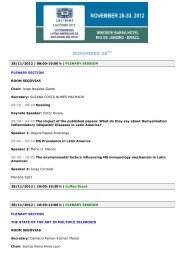Keynote Conference - Interevent
Keynote Conference - Interevent
Keynote Conference - Interevent
You also want an ePaper? Increase the reach of your titles
YUMPU automatically turns print PDFs into web optimized ePapers that Google loves.
Symp#13 Vascular cell biology<br />
Chair Robson Monteiro<br />
Tumor-Derived Microvesicles and their Role in Cancer Progression<br />
Robson Q. Monteiro<br />
Institute of Medical Biochemistry, Federal University of Rio de Janeiro, Rio de Janeiro, Brazil<br />
Shedding of phosphatidylserine (PS)-containing microvesicles (MVs) by cancer cells have been correlated with several pro-tumoral<br />
responses. In addition, the procoagulant properties of MVs suggest their involvement in the establishment of cancer-associated<br />
prothrombotic states. Comparison of MVs produced by a non-tumorigenic melanocyte-derived cell line (melan-A) with its<br />
tumorigenic melanoma counterpart, Tm1, showed an increased rate of MVs production upon malignant transformation. Moreover,<br />
tumor-derived MVs displayed increased levels of the clotting initiator protein, tissue factor (TF). As a result, Tm1 but not melan-aderived<br />
MVs accelerated thrombosis in vivo. Analysis of plasma obtained from melanoma-bearing mice showed the presence of MVs<br />
with a similar procoagulant pattern as compared to Tm1 MVs produced in vitro. Remarkably, flow-cytometric analysis demonstrated<br />
that 60% of ex-vivo MVs are TF-positive and carry the melanoma-associated antigen, demonstrating its tumor origin. These data<br />
reinforce the possible involvement of tumor-derived MVs in the establishment of cancer-associated hypercoagulant states, indicating<br />
an important role for TF in this process. Since MVs may horizontally transfer their cargo between different cells, we further<br />
investigated the exchange of TF-bearing MVs between human breast cancer cell lines with different aggressiveness potential.<br />
Incubation of low aggressive MCF-7 cells with MVs from the aggressive cell line, MDA-MB-231, rendered a significant gain of TF<br />
activity. This phenomenon was not observed upon pretreatment of MVs with an anti-TF neutralizing antibody or annexin V, which<br />
blocks PS sites on MVs surface. These data indicate that TF-bearing MVs can be transferred between different populations of cancer<br />
cells, and thus may contribute to the propagation of a TF-related aggressive phenotype among heterogeneous cell subsets present in<br />
the tumor microenvironment.<br />
This study was supported by the Brazilian agencies CNPq and FAPERJ.<br />
Cell Adhesion and Signaling Pathways in Neurovascular Development<br />
Joseph H. McCarty<br />
Department of Cancer Biology, University of Texas M.D. Anderson Cancer Center, 1515 Holcombe Boulevard, Houston, Texas, 77030,<br />
U.S.A.<br />
The mammalian central nervous system contains billions of neurons and glia that are interlaced with an elaborate network of blood<br />
vessels comprised of endothelial cells, pericytes and vascular basement membranes. During development blood vessels grow and<br />
sprout along a pre-formed latticework of glial cells; however, the mechanisms by which glial cells control central nervous system<br />
neovascularization remain enigmatic. We have used Cre-lox strategies in mice to demonstrate that αvβ8 integrin expressed in glial<br />
cells is essential for neovascularization of the developing central nervous system. Cell type-specific inactivation of αv or β8 integrin<br />
gene expression in radial glia using a Nestin-Cre transgene leads to the development of hemorrhagic blood vessels that form<br />
glomeruloid-like tufts in the embryonic brain and the neonatal retina. These pathologies correlate with diminished activation of latent<br />
TGFβs, which are extracellular matrix-bound protein ligands for αvβ8 integrin. Genetic ablation of canonical TGFβ receptors Alk5 or<br />
TGFβR2 in vascular endothelial cells during embryogenesis result in brain vascular pathologies that are identical to those in integrin<br />
conditional knockout mice. Furthermore, tamoxifen-inducible inactivation of TGFβ receptor signaling in retinal endothelial cells also<br />
leads to defective angiogenesis and intraretinal hemorrhage. Collectively, our data demonstrate that αvβ8 integrin and TGFβ<br />
receptors are components of a paracrine signaling axis that links glial cells to endothelial cells during central nervous system vascular<br />
development.<br />
Vascular growth factor signaling in neurogenesis<br />
Jean-Léon Thomas #, Anne Eichmann *<br />
Departments of Neurology # and Cardiovascular Medicine * , Yale School of Medicine, New Haven, CT, USA<br />
# Brain and Spinal Cord Institute, Paris, France<br />
In the adult mammalian brain, the potential to generate new neurons is restricted to a limited number of sites called neurogenic<br />
niches, which are localized in the subventricular zone (SVZ) lining the cerebral ventricles and in the dentate gyrus (DG) of the<br />
hippocampus. Injury of brain tissue resulting from trauma or pathologies activates neurogenesis in these niches, attesting to an<br />
endogenous repair potential that is generally not sufficient to allow a complete rescue. To enhance this endogenous neurogenic<br />
response without negative side effects, it is crucial to characterize the mechanisms which are active in neurogenic niches.<br />
Functionally, members of the vascular endothelial growth factor (VEGF) family stimulate adult neurogenesis and neuronal plasticity,<br />
opening potential approaches for repair of neurodegenerative diseases. However, it has been unclear whether VEGFs stimulate<br />
neurogenesis directly via VEGF receptors (VEGFRs) expressed by neural cells, or indirectly via the release of growth factors from<br />
angiogenic capillaries. We have reported that the lymphangiogenic growth factor VEGF-C is expressed by neural cells and provides<br />
trophic support to neural progenitor cells during brain development (Le Bras, Nat Neurosci, 2006). Here, we will discuss our latest<br />
findings on its receptor VEGFR-3, which is expressed by adult NSCs, and is critical for adult neurogenesis by acting directly in NSCs and<br />
niche astrocytes, but not endothelial cells (Calvo, Genes Dev., 2011).<br />
65





